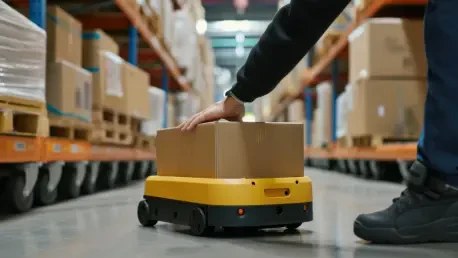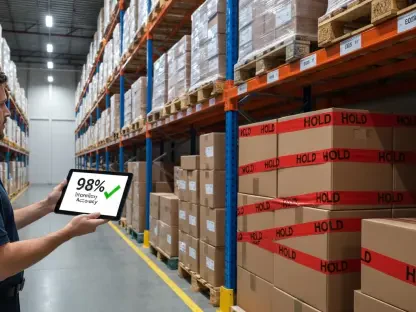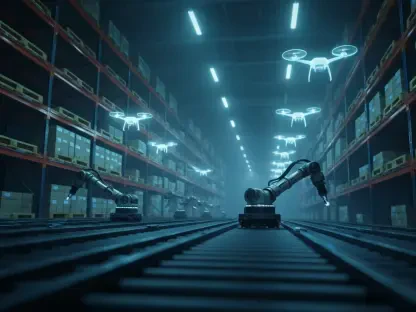The warehouse and logistics industry stands at a critical juncture, grappling with unprecedented demand for faster, more adaptable operations as e-commerce continues to surge. With global supply chains under pressure to deliver goods at lightning speed, companies are increasingly turning to automation to streamline processes and reduce errors. This shift is not just a trend but a necessity, as retailers face mounting challenges in managing diverse inventories and fluctuating order volumes. The introduction of cutting-edge solutions like Geekplus’s PopPick Lite at Søstrene Grene’s distribution center in Venlo, Netherlands, exemplifies how technology is reshaping the sector, promising a deeper dive into the mechanics of this transformation.
The Growing Role of Automation in Warehouse Operations
The logistics landscape has evolved dramatically, driven by the need for efficiency in an era where same-day delivery is becoming the norm. Warehouses are no longer mere storage spaces but dynamic hubs that must handle vast product ranges and complex order fulfillment processes. This evolution is particularly evident in regions like the Nordics and Benelux, where high labor costs and stringent efficiency expectations push companies to adopt innovative solutions. Automation has emerged as a cornerstone, enabling businesses to optimize space, reduce operational delays, and meet customer demands with precision.
Among the key players in this space, Geekplus has carved out a significant role by delivering robotics solutions that address real-world challenges. Their focus on scalable and flexible systems aligns with the industry’s pivot toward adaptability, especially as retailers navigate seasonal peaks and unpredictable market shifts. In the Nordics and Benelux, where logistics networks are highly advanced, the adoption of such technologies signals a broader movement toward fully integrated, automated ecosystems that promise to redefine operational benchmarks.
Unveiling PopPick Lite: A Game-Changer for Warehouse Efficiency
Key Features and Implementation Details
At the heart of the automation revolution is Geekplus’s PopPick Lite, a Shelf-To-Person system recently deployed at Søstrene Grene’s 3,000-square-meter distribution center in Venlo, Netherlands. This setup includes 64 P1200 robots, 8 picking stations, over 400 racks, and 300 pallet locations, creating a seamless workflow that minimizes manual intervention. The system is designed to transport goods directly to workers, significantly cutting down on travel time within the warehouse and streamlining the picking process.
A standout aspect of PopPick Lite is its modularity, allowing for easy adjustments to meet changing operational needs. Its scalability ensures that as order volumes grow, the system can expand without requiring a complete overhaul of existing infrastructure. Additionally, ergonomic benefits for workers are a priority, with picking stations designed to reduce physical strain by positioning items at optimal heights and integrating intuitive interfaces that enhance user comfort.
The implementation also features advanced integration, such as conveyors linked to a put wall, accommodating various product sizes from small items to larger pallets. This flexibility not only maximizes space efficiency but also minimizes the footprint of fixed machinery, preserving valuable floor area for other uses. Such thoughtful design elements underscore the solution’s role as a tailored response to modern warehouse demands.
Impact on Operations and Performance Metrics
For Søstrene Grene, a Danish lifestyle retailer facing a diversifying product portfolio and escalating order volumes, PopPick Lite offers a strategic solution to operational bottlenecks. The system tackles the complexity of managing an expansive inventory by automating the retrieval and sorting processes, ensuring that workers can focus on higher-value tasks. This shift has directly addressed the retailer’s need for a robust framework capable of handling growth without sacrificing speed or accuracy.
Claus Tjærby, Chief Supply Chain Officer at Søstrene Grene, has highlighted the tangible benefits of this deployment, noting substantial improvements in throughput and order accuracy. The automation has enabled the distribution center to process a higher volume of orders with fewer errors, a critical factor in maintaining customer satisfaction in a competitive retail environment. These metrics reflect a broader enhancement in overall efficiency, positioning the company to better navigate market fluctuations.
Beyond raw numbers, the system’s impact extends to operational reliability, providing a predictable workflow that reduces downtime and optimizes resource allocation. This consistency is vital for a retailer aiming to future-proof its logistics amidst rapid industry changes. The success of this project illustrates how targeted automation can transform specific pain points into competitive advantages, setting a precedent for others in the sector.
Challenges in Adopting Warehouse Automation
Implementing automation solutions like PopPick Lite is not without hurdles, with initial costs often posing a significant barrier for many organizations. The investment in robotics and system integration can be substantial, requiring careful financial planning and justification of long-term returns. For smaller or mid-sized companies, this upfront expenditure can delay adoption, even when the benefits are clear.
Beyond finances, integrating new technology with legacy systems presents technical challenges that demand expertise and patience. Ensuring compatibility and minimizing disruptions during the transition phase are crucial to maintaining operational continuity. Additionally, workforce adaptation remains a concern, as employees must be trained to interact with automated systems, sometimes overcoming resistance to change or addressing skill gaps.
To mitigate these obstacles, strategic partnerships play a pivotal role, as seen in the collaboration between Geekplus and STL. Their combined expertise facilitates smoother deployments, while scalable and flexible technologies like PopPick Lite allow for phased implementations that reduce risk. By prioritizing adaptability and offering tailored support, such alliances help companies navigate the complexities of automation, ensuring that the benefits outweigh the initial challenges.
The Regulatory and Compliance Landscape for Warehouse Robotics
Navigating the regulatory framework for warehouse automation in the European Union requires a keen understanding of safety standards and labor conditions. Robotics systems must adhere to strict guidelines that protect both equipment and personnel, mandating features like emergency stop functions and collision avoidance. Compliance with these rules is non-negotiable, as violations can lead to costly penalties or project delays.
Employee working conditions also fall under regulatory scrutiny, with emphasis on ergonomic design and safe interaction between humans and machines. Authorities mandate that automation solutions enhance rather than hinder worker well-being, influencing system layouts and operational protocols. For companies like Geekplus, aligning with these standards during the design phase is essential to avoid rework and ensure seamless deployment.
The impact of compliance extends to project timelines and overall system architecture, often requiring additional testing and documentation. While this can slow down implementation, it ultimately fosters trust and reliability in automated operations. Staying ahead of regulatory changes and embedding compliance into the core of technology development remain critical for sustained success in the European market.
Future Trends in Warehouse Automation and Robotics
The trajectory of warehouse automation points toward an increasing reliance on mobile robotics, driven by the imperatives of speed, flexibility, and scalability. As logistics operations strive to keep pace with e-commerce growth, systems that can rapidly adapt to varying workloads and space constraints are gaining prominence. This trend is reshaping how warehouses are designed, prioritizing dynamic layouts over static configurations.
Emerging technologies, such as advanced machine learning and enhanced sensor systems, are poised to further revolutionize the field by improving robot decision-making and environmental awareness. Potential market disruptors, including smaller, agile robotics firms, could challenge established players by offering niche, cost-effective solutions. Meanwhile, the emphasis on human-centric design continues to grow, ensuring that automation complements rather than replaces the workforce.
Looking ahead, collaborations like the one between Geekplus and STL are expected to drive innovation, focusing on replicable models that shorten deployment times. Their partnership exemplifies a commitment to addressing evolving retail needs through tailored automation. As the industry progresses, integrating these advancements with a focus on worker well-being and operational agility will likely define the next wave of logistics transformation.
Conclusion: Redefining Logistics with Strategic Innovation
The deployment of PopPick Lite at Søstrene Grene’s distribution center marked a significant milestone in warehouse automation, demonstrating how targeted technology could address specific operational challenges with remarkable efficiency. This initiative not only enhanced throughput and accuracy but also improved working conditions through ergonomic design, setting a high standard for the industry. The collaboration between Geekplus and STL proved instrumental in achieving these outcomes, showcasing the power of strategic alliances in driving rapid progress.
Reflecting on this success, the broader warehouse robotics sector gained valuable insights into balancing innovation with practicality. Moving forward, companies should prioritize scalable solutions and robust partnerships to tackle the complexities of modern logistics. Investing in technologies that adapt to changing demands while maintaining compliance with regulatory standards emerged as a key takeaway. This approach, coupled with a focus on human-centric automation, offered a clear path to sustaining growth and competitiveness in retail distribution for years to come.









